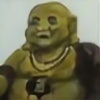HOME | DD
 tjkyb — Shishiguchi Mask
tjkyb — Shishiguchi Mask

#aku #buddhist #demon #demonmask #drawing #foo #foodog #fu #fudog #fujin #gagaku #handmade #hannya #japan #japanese #kabuki #kagura #kishin #lion #mask #monster #mountainlion #mouth #myth #mythology #netsuke #nioh #noh #nohmask #omote #oni #pencil #raijin #shikami #shinto #shishi #tengu #theater #traditional #zen #kyogen #bugaku #gigaku #shakkyo #shishiguchi #buryu #kojishi #iwami #nohgaku #ojishi #japaneseart #japanesemyth #japanesemythology
Published: 2018-03-17 19:49:44 +0000 UTC; Views: 2616; Favourites: 22; Downloads: 0
Redirect to original
Description
Noh mask: Shishiguchi (Hōshō pattern) - “Lion’s mouth”
I don't have any digital drawing skills as I grew up learning to draw with pencil/paper and have stuck to it throughout the years. Therefore, this is a traditional drawing using pencils. So far this is the only mask I have drawn, but I plan to draw more Japanese masks once I've graduated from University in a month's time. Also this was my first time using a blending stump.
Shishi are very popular and are more commonly known as “Fu dog”, or “Foo dog” in the West. Although the word "Shishi" is translated as "lion", Japanese Shishi masks, in general, represent the role of the Shishi as a fierce spirit and minor guardian deity in the Buddhist pantheon, rather than being a depiction of a lion/ animal. Shishi masks have a long history of use in Japan, with roots in Chinese folk religions/ Buddhism. These masks, including the Shishiguchi, are thought to have been developed from the Konron and Rikishi (Gigaku) masks, which were brought to Japan from China during the Asuka period (552-645 CE). The earliest evidence for distinctive Shishi style masks possibly dates back to as early as the Kamakura (1185-1333) period in Japan. (Marvin, S. E. 2010; en.wikipedia.org/wiki/Chinese_… )
Noh theater is a performing art tradition, with roots in folk religion/spirituality/dance, incorporating Shinto and Buddhist themes, and is often referred to as the “classical theater” form of Japan. Noh theater, as a distinct art form, is thought to have emerged and differentiated itself during the Muromachi (1336-1573) period, with Kan’ami Kiyotsugu (1333-1384) and his son, Zeami Motokiyo (1363-1443) appearing as prominent figures in its development. Coinciding with its increasing popularity among the elite, elements of Zen Buddhism were extensively incorporated into Noh throughout the Muromachi period. Noh theater reached its peak in popularity during the Edo period (1603-1868), and was reserved mainly for the upper classes, as many of its themes appealed greatly to the warrior aristocracy. It was during this time that Noh theater became heavily ritualized, and thus, the way Noh theater is performed today is extremely similar to how it was performed hundreds of years ago. (Choo, L.B. 2012; Marvin, S.E. 2010; Motokiyo, Z., & Wilson, W. S. 2013; www.the-noh.com/en/plays/data/… )
The Shishiguchi mask is used in Noh theater, almost exclusively in the play Shakkyō (Stone Bridge). This play is well-known for its unique lion dance, performed at the end of the play, which is not associated with the earlier Chinese or Japanese lion dances, which made it a popular entertainment piece to perform for foreign dignitaries. Additionally, the Shishiguchi type of mask was also infrequently used for the play Ryōko (The dragon and the tiger). However, this play was only popular for a short period of time, during the reigns of the Tokugawa Shoguns Tsunayoshi (1646-1709), and Ienobu (1662-1712), recorded as being performed a total of 17 times over a 30-year timespan, and is only rarely performed today. (Choo, L.B. 2012; Marvin, S.E. 2010; www.the-noh.com/en/plays/data/… )
If you are interested, I’ve included some links at the bottom of this description.
The 1st link is a synopsis of the play Shakkyō, the website also features many different aspects of Noh theater and I highly recommend checking it out in more depth if you are interested.
The 2nd and 3rd links are parts 1 and 2 of the play Shakkyō, which I’ve found on youtube (approximately 50 minutes in length).
The 4th link is a brief sample of the lion dance performed in Shakkyō (approximately 31 seconds), also on youtube.
Link 1: www.the-noh.com/en/plays/data/… l30.htm
Link 2: Shakkyo 1 of 2 www.youtube.com/watch?v=zFW7ru…
Link 3: Shakkyo 2 of 2 www.youtube.com/watch?v=6b3X19…
Link 4: Lion Dance www.youtube.com/watch?v=QTtRzK…
References:
Books
Choo, L. B. (2012). Another stage: Kanze nobumitsu and the late muromachi noh theater . Honolulu: Univ Of HawaiI Press.
Marvin, S. E. (2010). Heaven has a face, so does hell: The art of the Noh mask . Warren, Conn: Floating World Editions.
Motokiyo, Z., & Wilson, W. S. (2013). The spirit of noh: A new translation of the classic noh treatise the Fushikaden . Boston: Shambhala.
Websites
en.wikipedia.org/wiki/Chinese_…
www.the-noh.com/en/plays/data/…
www.youtube.com/watch?v=zFW7ru…
www.youtube.com/watch?v=6b3X19…
www.youtube.com/watch?v=QTtRzK…
Related content
Comments: 5

Thanks a lot! Yea, it took some time... honestly don't know how much because I just like drawing for fun and don't pay attention to that right now.
I'm working on another mask right now that's taking longer and so far I like the look of it better.
👍: 0 ⏩: 0



















